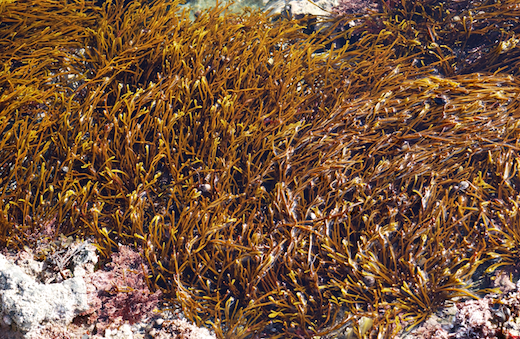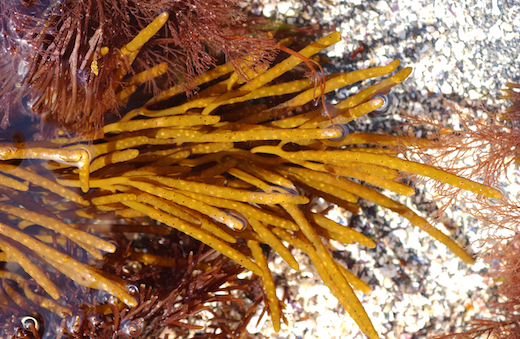Bifurcaria bifurcata R.Ross

Also known as Bifurcaria rotunda (Hudson) Papenfuss and B. tuberculata Stackhouse.
English name: Brown Forking Weed, Brown Tuning Fork Weed.
Description: Cylindrical, rich yellow-brown, 300-500 mm long (picture above). Fronds tough, cylindrical, smooth, narrowly forked from about half way up the thallus. Holdfast composed of persistent, intertwined rhizoidal growths. Receptacles (picture below) cylindrical elongated at apices with many conceptacles visible as lighter coloured spots. Ostioles usually prominent. Antheridial conceptacles usually above and oggonial conceptacles below. Inconspicuous, simple air vesicles occasionally found at the base of the receptacles.
Habitat: In Britain and Ireland mostly found in pools at about MTL, occasionally at low water on wave-washed ledges. Further south on open rock at low water, sometimes zone-forming.
Distribution: SW Britain and W Ireland N to Donegal, often referred to as a "Luisitanian species". More or less absent from the south
coast of Ireland probably becasue of suitable habitat. Most common in limestone areas, and associated with the Black Sea Urchin, Paracentrotus lividus and the coralline alga Lithophyllum incrustans. Bifurcaria is a particular feature of the Burren in Co. Clare, particularly around Black Head, Kilkee and Spanish Point. Populations persisting in poold for many years. South to Morrocco and Western Sahara.
Key characteristics: Cylindrical thallus, rhizoidal holdfast, regular narrow forking.
Similar species: Halidrys siliquosa also occurs in similar pools but is profusely alternately branched with compressed fronds in the plane of branching, and commonly has compartmented floation structures with the shape of pea-pods.

Photographs © M.D. Guiry





